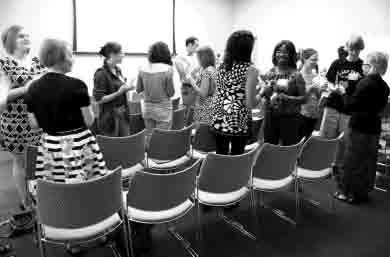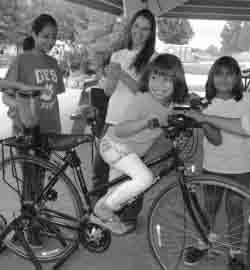
6 minute read
Green
from Sept. 13, 2012
Lane merging
More changes to driving and bike lanes are on the horizon in Reno after the Reno City Council held a meeting on Aug. 29 and voted to move forward with several road conversions.
Advertisement
“During the Sutro Street presentation, the RTC showed where they were going to reconfigure vehicle travel lanes into sidewalks and bike lanes between Fourth Street and Oddie, and decrease the four travel lanes into two plus a turn lane,” Scott Hall, chairman of the Committee for Bicyclists on 4th Street, wrote to us in an email. “North of Oddie, there would be no bicycle lanes, but a shared parking [and] bike lane would go up the hill from Wedekind to Hug High School. ... The Reno City Council voted to adopt the RTC preferred alternative, which they said the neighborhood community supported.”
Plans for Plumas Street were also discussed at the meeting, with council member Sharon Zadra supporting keeping four travel lanes and adding in bicycle lanes from Urban Street to Moana Lane. Reno city traffic engineers Steve Bunnell and John Flansberg agreed with Zadra.
Others disagreed. “This configuration would be extremely tight, and put bicyclists next to high speed traffic with a curb blocking the side,” said Hall.
Mayor Bob Cashell did not support a four lane plan for Plumas Street, but supported a plan to reduce Mayberry Street from four lanes to two in order to improve safety.
Scott Gibson, a city traffic engineer, presented data showing that other Reno road conversions reduced traffic accidents by 40 percent. Ultimately, Hall said, the Council compromised with a three lane design for Plumas Street—two lanes southbound, and one lane northbound—which will be studied throughout the next year to determine safety and traffic conditions.
“I think we are seeing more changes in the attitudes of Reno about bicycling and walking, and that our investments and decisions already made by the city of Reno, and supported today in Council meetings, mean that we will be benefiting more and more as a community in the rebirth of Reno,” Hall says.
Stacked up
Sure, phonebooks are useful for some things, like keeping a door propped open, but with internet databases, the books have long been regarded as wasteful and outdated by environmental organizations, including recycling and sustainability non-profit Keep America Beautiful. According to local KAB affiliate Keep Truckee Meadows Beautiful and YP Real Yellow Pages, it’s the time of year to opt out of receiving phone books. To do so, visit www.yellowpagesoptout.com to register your household. KTMB also notes that old phone books can be recycled through curbside recycling.
Washoe expands its web
The Washoe County Health District is using web resources to encourage residents to participate in local health initiatives. The WashoeEats website, which allows residents to view food inspections conducted on regional restaurants, was launched in February and now has a mobile version that is designed to be used on smartphones and tablets. Visit http://m.eats.washoecounty.us/.
Locals can also find smoke-free locations by using www.smokefreemeetings.org, which lists around 60 smoke-free places in Washoe County, Carson City and Storey County, according to the website. Each location is “100 percent smoke-free”: “A smoke-free meeting location is defined as a location where smoking is not permitted anywhere inside the entire facility or place of business,” the website says.
—Ashley Hennefer
ashleyh@newsreview.com
ECO-EVENT
The sixth annual Green Living Festival will be held on Sept. 15 in Gardnerville. The event will offer activities for kids, food, music, exhibitors and presentations, and local organizations such as the Discovery Museum and Full Circle Compost will be on hand to lead demonstrations. 9 a.m.-4 p.m. Free admission and parking. Lampe Park, Gardnerville. For more information, visit www.greenlivingfest.org.
Got an eco-event? Contact ashleyh@newsreview.com. Visit www.facebook.com/RNRGreen for more.

PHO TO/A SHLEY HENNEFER
Attendees participated in an activity in which they discussed the resources their organizations possessed and lacked.
Justice league
Rural & Urban Nevada Social Justice Institute
The local and organic food movements are just as much about people as they areabout by Ashley the environment—especially when they can aid in tackling the food crisis in Nevada’s rural counties.
Hennefer The food insecurity and nutrition workshop, held at the Joe Crowley Student Union on Sept. 7, was part of the Rural & Urban Nevada Socialashleyh@ newsreview.com Justice Institute, and addressed how “food security is related to social justice,” according to speaker Christy McGill, director of the Healthy Communities Coalition. The workshop brought together local food and outreach leaders, including members from Urban Roots Garden Classroom, Washoe County School District, local food banks and area non-profits such as Justice for Immigrants. McGill and Freida Carbery, volunteer coordinator with Healthy Communities Coalition, spoke of collective impact and individual impact. The Healthy Communities Coalition focuses on the general wellness of Lyon and Storey counties, and has several food initiatives. According to McGill, much of Nevada is a “food desert”—communities in which healthy food is difficult to obtain, largely due to economic status—and many residents of Lyon and Storey counties rely on the food provided by the counties’food closets. Carbery talked about the importance of empowerment, ensuring that For more information residents know what to do with the foods they are given to make healthy about Healthy meals for their families. Communities Coalition’s “We want to empower the people using the services,” she said. “Whoefforts, visit www.healthycomm.org. knows better how it feels than those who use the service? … It’s about how a person feels when they walk out of that room [at the food bank]. We need to ask them, ‘Can you confidently cook those green beans?’” Many of the plans discussed at the workshop included collaboration between food banks, schools and farmers—providing farmers with a larger market by bringing their produce into schools and growing essentials needed by the community. In Silver Springs, children from the local schools collaborated with farmers to host a farmers’market, where residents were able to use coupons distributed by the Northern Nevada Food Bank. An electronic benefits transfer (EBT) machine was also available, allowing for the use of Supplemental Nutrition Assistance Program (SNAP) benefits to purchase locally grown produce. McGill talked about the goals for the “Good food for all” plan, which includes “access to quality food for the Western Nevada region; economic vitality for regional producers, manufacturers, distributors and purveyors; natural resources used well; [and] citizens are a part of a healthy food system where eating, growing and cooking healthy, sustainable food becomes more important in daily community life and common knowledge.” McGill closed the workshop by saying, “Atwo track food system is not healthy or profitable for Nevada,” she said. A“two track food system” is often used to describe the imbalance between members of the public who can afford to buy healthy and organic foods, and those whose economicstatus prevents them from doing so. Ultimately, the message of the day was simple—Nevada needs more farmers and more individuals who can contribute to the state’s demand for healthy food. “Befriend a farmer,” McGill said. “It’s worth your time.” Ω
















